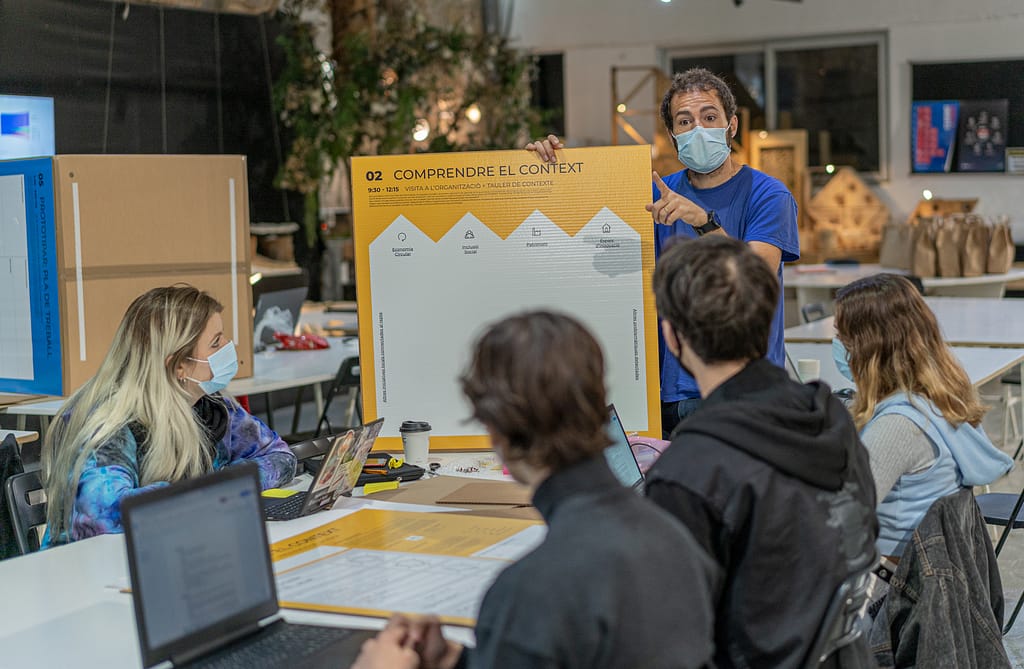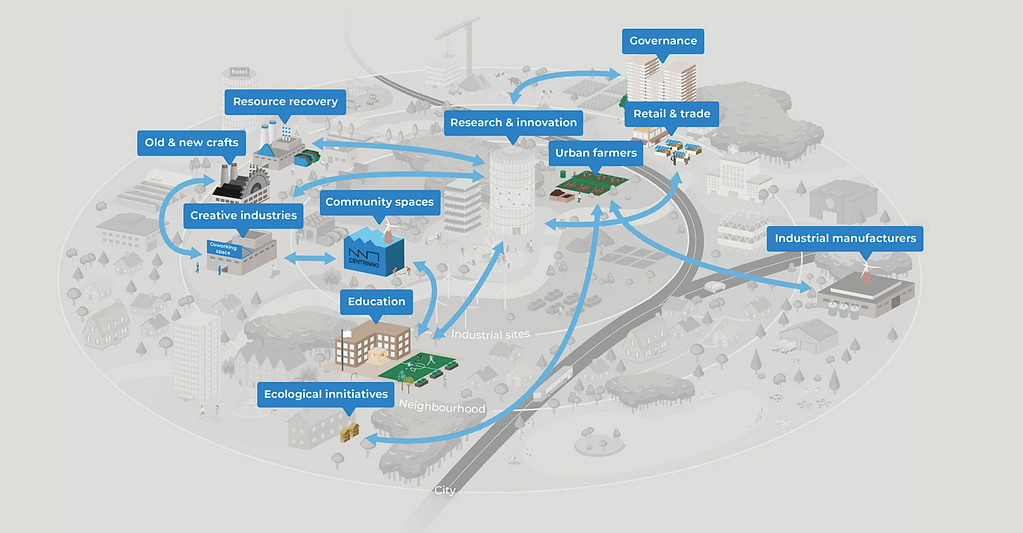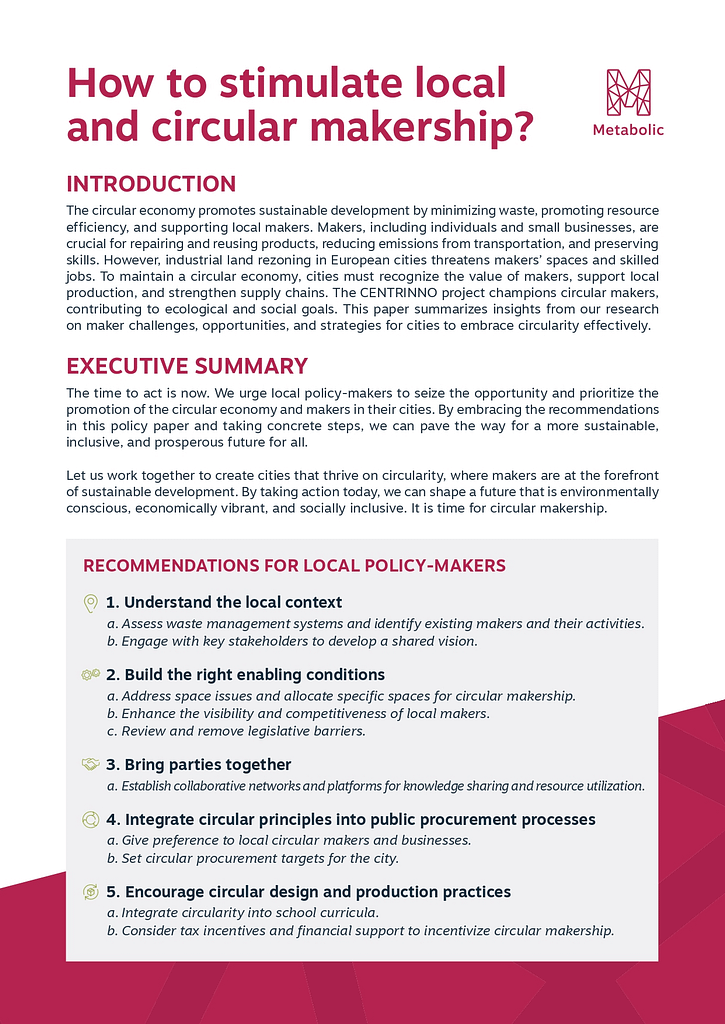While working to empower circular makers, the EU CENTRINNO project highlighted the need for comprehensive policy for sustainable urban development that ensures the livelihood of diverse workforces.
In the heart of Europe’s factories and cities, the CENTRINNO project had a big goal: to breathe new life into old industrial spaces and champion a way of working that benefits everyone. Supported by the European Horizon 2020 program, CENTRINNO aimed to transform nine historical sites across Europe into creative, locally productive, and inclusive hubs.
From Amsterdam to Blönduós, Iceland, we saw that despite how diverse the cities are in their heritage, they faced many shared challenges: gentrification, high housing prices, and a loss of affordable workspaces.
Tacking these systemic challenges for makers in former industrial places requires policy action. City-wide strategies are needed to ensure the continued livelihood of a diverse workforce, which will be increasingly important in a future where local resource sovereignty and circularity gain importance. Our team at the Metabolic Institute offers recommendations to guide policymakers who are trying to stimulate circular local makers.
While these policy recommendations focus on this specific realm, while leveraging knowledge like this pulled from across our ecosystem, our team is also working with a group of highly regarded organizations to drive systemic change for Europe. Through a new collaboration, The Systems Transformation Hub, we aim to support EU policymakers in implementing impactful policies for systemic change to address the current crises and to move from an economy centered around human wealth to an economy that balances the needs of people, climate, and nature. The Hub launches on January 24 at the European Parliament in Brussels; register here to join online.
The CENTRINNO Journey
With the project partners, the Metabolic Institute focused on nine places in Europe deeply rooted in history. CENTRINNO wanted to give new life to these places and make them part of new, better cities — where everyone could be involved, history paved the way to new ideas, and diverse jobs could flourish. More than a collection of buildings or products, cities could be built around the woven narratives and cultures of their people.

Over three years, the 27 partners explored two former industrial spaces each year in cities like Amsterdam, Barcelona, Geneva, Paris, Milan, Copenhagen, and even the small town of Blönduós in Iceland.
In Amsterdam, we saw makers unite to speak up against urban development that could jeopardize their livelihoods. In Geneva, where dozens of artisans, artists, manufacturers, and repairers, worked in one of the remaining industrial zones, we met the organizations working on new collaborative manufacturing models for shared spaces, tools, and infrastructure, where young people could learn the digital skills to produce sustainable and circular goods. In Blönduós, we learned about digital weaving technologies that combine the country’s wool heritage with modern tools.
From the polders to the glaciers, people across Europe encountered the same types of challenges, namely gentrification, rising housing prices, and a loss of affordable spaces for our productive and industrial workforce.
Recommendations for Local Policy-Makers
Recognizing the need for policy interventions, CENTRINNO and its sister programs compiled a comprehensive policy report, which you can find here.
In parallel, the Metabolic Institute wrote an additional policy paper, offering five actionable recommendations based on the insights gained from the three-year pilot:
- Understand the local context
To effectively stimulate circular makership, it is crucial to first understand the unique local context of the city. Conduct an overview of the city’s waste management and recycling systems to identify existing opportunities for circularity. Identify key stakeholders, including local government, industry, civil society, and academia, and engage with them to develop a shared vision of the roles and opportunities for circular makers. Speaking directly with these local makers provides valuable insights into their specific challenges and needs. The CENTRINNO Cartography provides tools and methods to help policymakers map the local ecosystem of stakeholders and initiatives.

- Build the right enabling conditions
For circular makership to thrive, the environment must be able to foster it. These enabling factors can be divided into four categories: space, competitiveness, legislation, and engagement of local makers.
Many local makers in the CENTRINNO cities couldn’t find affordable space for their activities. More spaces need to be allocated to local makers. A shift to circular makership also means a significant shift in business models, so assistance with training and financial support is important. Local makers often know the policy problems but might not know how to communicate this, so active engagement from policymakers ensures that these insights are embedded in local policy.
- Bring parties together
To close resource loops, it is important to connect different stakeholders in the supply chain. This could be accomplished by facilitating a network for knowledge and resource sharing.
- Integrate circular principles into public procurement processes
How a municipality spends its money has a huge influence on the local economy. Adapting the procurement processes can give a huge boost to stimulate the local circular economy. Setting circular procurement targets could allow a circular economy in their city to thrive by giving it the initial investment that it needs.
- Encourage circular design and production practices
Lastly, the circular economy could be stimulated by providing relevant training and even integrating circularity into the curriculum in schools. Moving towards a circular business model often requires a change in the way people do things, and tax incentives and financial support could be considered.
A vibrant future
At the heart of our work at Metabolic, the circular economy promotes sustainable development by minimizing waste, promoting resource efficiency, and supporting local makers. Makers, including individuals and small businesses, are crucial for repairing and reusing products, reducing emissions from transportation, and preserving skills. However, industrial land rezoning in European cities threatens makers’ spaces and skilled jobs.
To maintain a circular economy, cities must recognize the value of makers, support local production, and strengthen supply chains. Policymakers can seize this opportunity to prioritize and promote the circular economy in their cities, where makers are at the forefront of sustainable development. By taking action today, we can shape a future that is environmentally conscious, economically vibrant, and socially inclusive.





